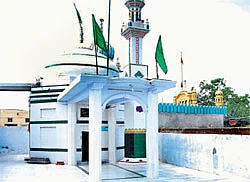
Perhaps, it’s this mystifying vibe that has firmly held for decades an impeccable bond of inter-religious co-existence in the village. It’s not hard to figure out why? It’s a place, perhaps the lone one, where Hindus and Sikhs together run a mosque.
There is no Muslim in this village which has about 300 houses and a population of about 2,000. And for over six decades Hindus and Sikhs have been managing this mosque with utmost devotion and care, if not better, at least as good as the other mosques elsewhere.
The legacy of coexistence has stretched across generations in the village. It’s a model that has left lessons of harmony and hope for warring communities. The guardians of faith in the village dutifully perform rituals each day at the mosque. What’s more, this mosque not only shares its space with people from other religions, but also has its wall common with the village Gurdwara (Sikh shrine).
From a distance, the mosque and the Sikh shrine side by side present a picture perfect. The elderly people in the village recall that the mosque was built in the memory of Sufi saint Baba Noor during the pre-partition era. Then it was a village with a sizable number of Muslims. After partition things changed as Muslims left, leaving behind their symbol of faith and worship, 95-year-old Gurnam Singh said. The 25-foot tall mosque has stood tall over decades.
Not that people don’t visit temples and Sikh shrine in the village, but every household has a special connection with the mosque, perhaps stemming out of the legacy they have inherited. The village presents a peculiar site, something that surprises the people at first look. There are no double-storeyed houses in the village. Not that they can’t afford.
Many of them have the resources to build multi-storeyed buildings. Here why?
Call is superstition or bad luck. But the practice has held the ground for long. The belief is that any construction that goes above the height of the mosque would spell misfortune and bring bad luck. Most of the villagers have chosen not to violate this norm. Villagers recount stories that have held their belief in this practice.
Gurnam Singh said a landlord had once built a towering mansion in the village since he had the wealth and wanted to live differently than others. He decided to bring down its height after he lost his brother. “People fall sick or lose their cattle. It brings misfortune if disregard is manifested,” he said.
It is also believed that a worshipper’s wish is fulfilled if he pays obeisance on a Thursday. Thursdays are special days here. This is the holiest day during the week. Throughout the day, visitors from nearby villages, towns and cities pay obeisance at the shrine. Dutifully, Hindus and Sikhs tasked with the upkeep and service of the mosque engage themselves in rituals and service of devotees.
A visit to the mosque before a wedding or a celebration, or even before start of cropping season is almost a must. It brings good luck, villagers believe.
Head of the managing committee of the mosque Happy Singh Gill said the upkeep is the responsibility of Sikh and Hindu volunteers. At times, especially during festive season, it was hard to perform particular rituals laid down for Muslims. But, the committee found a way out. They have on rolls a Muslim priest who occasionally travels all the way from Malerkotla district, an area having large number of Muslims and represented by a woman Muslim MLA, to offer prayers as laid down, Gill said.
